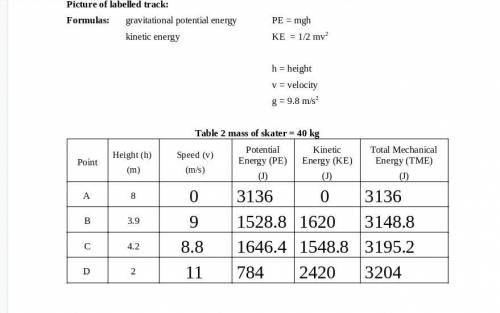
Physics, 21.12.2020 05:50 malikfitzgerald1910
Calculate the ratio of the total energy at B to the total energy at A and also the ratio from C to B and from D to C. What do these ratios tell you about the conservation of energy?
(TMEB/TMEA) = 1.00408163265
(TMEC/TMEB) = 1.01473577236
(TMEC/TMED) = 1.02846441948
QUESTIONS THAT NEED TO BE ASNWERED:
Is the total mechanical energy conserved between A and B? Explain
Is the total mechanical energy conserved between B and C? Explain
Is the total mechanical energy conserved between Cand D? Explain


Answers: 3
Another question on Physics

Physics, 23.06.2019 01:00
Learning goal: to understand newton's 1st law. newton's principia states this first law of motion: an object subject to no net force maintains its state of motion, either at rest or at constant speed in a right line. this law may be restated as follows: if the sum of all forces acting on an object is zero, then the acceleration of that object is zero. mathematically this is just a special case of the 2nd law of motion, f⃗ =ma⃗ , when f⃗ =0. when studying newtonian mechanics, it is best to remember the 1st law in two ways: if the net force (i.e., sum of all forces) acting on an object is zero, the object will keep moving with constant velocity (which may be zero). if an object is moving with constant velocity, that is, with zero acceleration, then the net force acting on that object must be zero. complete the following sentences to see if you can apply these ideas. part a if a car is moving to the left with constant velocity, one can conclude that
Answers: 1

Physics, 23.06.2019 03:20
When a pendulum is held high and taut and then is released, the pendulum begins to swing. what’s the correct order of the energy transformations in this example? (pe stands for potential energy.)
Answers: 2

Physics, 23.06.2019 07:00
Conventional hot-water heaters consist of a tank of water maintained at a fixed temperature. the hot water is to be used when needed. the drawback is that energy is wasted because the tank loses heat when it is not in use, and you can run out of hot water if you use too much. some utility companies are encouraging the use of on-demand water heaters (also known as flash heaters), which consist of heating units to heat the water as you use it. no water tank is involved, so no heat is wasted. a typical household shower flow rate is 2.50 gal/min (9.46 l/min ) with the tap water being heated from 51.0 ˚f (10.6 ˚c) to 120 ˚f (48.9 ˚c) by the on-demand heater.what rate of heat input (either electrical of from gas) is required to operate such a unit, assuming that all the heat goes into the water?
Answers: 3

Physics, 23.06.2019 12:00
Which wave would cause destructive interference at every point of the wavelength and completely cancel out the wave?
Answers: 2
You know the right answer?
Calculate the ratio of the total energy at B to the total energy at A and also the ratio from C to B...
Questions




Mathematics, 02.08.2019 19:00

Mathematics, 02.08.2019 19:00







Spanish, 02.08.2019 19:10




Mathematics, 02.08.2019 19:10

Mathematics, 02.08.2019 19:10

Mathematics, 02.08.2019 19:10




